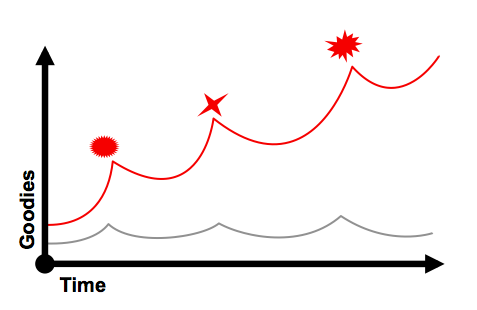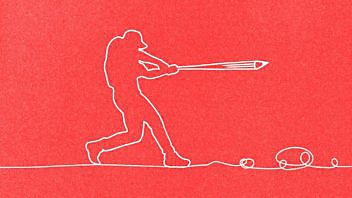[This is an update of our post on writing a great content brief. I wanted to add some new ideas and links.]
Great content brands and successful content marketing programs are built around ‘home run’ pieces – the big winners that really resonate with your audience and that deliver the lion’s share of results.
To illustrate this, we use this scientific chart, showing ‘Goodies over Time’. Goodies are anything you care to value and measure: traffic, views, shares, revenue… whatever.

The grey line is a typical content marketing program: you publish a piece, get a small spike and settle back down to the normal level.
The red line shows a content marketing program with some home runs in it. As shown, they spike way higher than the dull, gray peaks. But, more importantly, when they settle back down, they settle at a higher level. This is the creation of a great content brand – something we evanglised our hearts out about in the slildeshare Crap: Why The Biggest Threat to Content Marketing is Content Marketing.
But home-run pieces don’t happen by accident: they always start with a great content brief.
Brief-writing is the unsung art of content marketing. Get it right and you dramatically increase your chances of hitting a home run. Get it wrong and you’re more likely to win the lottery (it’s possible but don’t hold your breath).
And since most marketers aren’t the ones actually writing or designing or producing the content in their editorial calendars, a great content brief is the most important place to exert leverage and make an impact on the final product. It all starts here.
So what goes into a great content brief? The usual stuff plus seven critical extras you don’t see in many briefs.
The usual stuff for every content brief
Your content brief has to have all the things you should have in any brief for anything:
Goals – Why you’re doing what you’re doing. Thought Leadership. Money. Stuff like that.
Target Audience – Who you’re trying to reach (a rich persona doc will help). Get really specific here.
Main take-aways – An outline of the key points you need to burn into people’s brains. Short.
Support points – Why people should believe you. Super-important for any content writer.
Tone of voice – Statesmanlike, in-your-face, fun, hard-hitting…? I did a short interview on Tone of Voice here.
Executional notes – Format, guidelines, budget, timing…
These are the basics and all briefs must contain them.
But this isn’t where a great content brief stops, it’s where it starts. Now go on to:
The seven critical extras of a writing a great content brief
These are the things that separate a normal brief from a home-run brief:
1. Ambition – If you’re aiming high, say so. Tell the creators that you want to do something special; to hit a home run. Tell them why you think you can achieve this and what great looks like. If you don’t communicate your enthusiasm and ambition here, you’re unlikely to get something that makes your pulse go all irregular (in a good way).
Try something like this: “We want this piece to be the single best resource on the web for this topic. We feel we can own the search term ‘B2B Teapots’ if we can really add value to this important issue.”
2. Psychographics – You nailed the demographics in your persona document, but did you really nail the psychographics of your ideal prospect? Their beliefs and biases and loves and hates? This is where resonance hides. Nail it in the brief. For Velocity’s own content marketing briefs, we often include a line like this:
“We’re aiming for confident ambitious tech marketers with some power in their companies and the desire to do something great.”
3. The emotional target – Any brief summarises what you want the audience to think. This is where you say what you want your audience to feel. Great screenwriters start with an emotional target. So do great content creators. Know what you want people to feel and be clear about it in the brief.
For Salesforce, we discovered during the input work that one major reasons salespeople and marketers don’t collaborate better is that it’s awkward. They don’t speak the same language. They don’t really know how to talk to each other. So we produced a video that explores this obstacle and urges the two teams to overcome their embarrassment and get on with it:
https://www.youtube.com/watch?rel=0&showinfo=0&v=WW3ZdZaSuBw&feature=youtu.be
4. The key insight – Great content is always built on a crystal of insight. For a piece like Follow the Frog (one of my favourites), the insight is, “When confronted with a huge, global problem people tend to get paralyzed”. The film addresses this feeling directly and argues it’s not only okay to do something small, it’s actually the best option. Does your brief have a crystal of insight?
5. A world view – No content is an island. It exists in a marketplace that’s always changing. Your content has to emerge from a clear and compelling world view. That’s usually a big, specific change in the world that creates urgency for the thing you’re advocating. So nail that world view in the brief.
For the content we’re creating with Slack, the world view is all about how work itself is changing—getting more collaborative across more departments and more distributed teams—and how email just can’t keep up.
6. A story arc – The best content often tells a story. Maybe not a ‘Once upon a time’ story, but a narrative with a beginning that leads inevitably to a middle which steers you right to the end. Don’t leave your story arc to chance. Outline it in the brief.
For Sprint Business, we created content that told the story of how technology has hijacked business, sucking away valuable resources – and how companies can overcome this challenge. Very much a 3-act story structure.
For Open Market, the story arc was all about the power of empathetic interactions with customers and why text message are the ideal medium for many of them.
7. The competitive content – If you want your new content to be the best piece available on the web for this particular topic (you do, don’t you?), show the creators what content is out there now. Show what’s good about it and where it falls short.
Your content is always in competition with other content – not just from your direct, commercial competitors but from anyone publishing content on the topic. If you want to beat it… understand its strengths and weaknesses.
Put the Big Seven in your next content brief. See what happens.
Those are the Big Seven things I’d want to see in any content marketing brief that’s aiming for a home-run. When you really want a piece to have the best possible chance of leaping out, grabbing people by the lapels and shaking their lunch money out of them, make sure you hit all seven.
And if you want to write a great content strategy (instead of a single brief), you really need The B2B Content Marketing Strategy Checklist (no form, just a big, fat, juicy download with places for you to write stuff in).
Got any others? That’s what the Comments are for…

Enjoyed this article?
Take part in the discussion








Comments
Jim Burns October 30th, 2013
Doug I love the critical extras, especially key insights.
Re: competitive context, I think there are many more roles for curation than the vendors discuss. One is monitoring competitor content for the purpose you cite.
I have recently reviewed for clients, workshop, webinar and whitepaper content assets. When I asked for what I call the “Content Header” (mostly with your top category) so I understood those elements — context — they didn’t exist.
So the people requisitioning content aren’t clear what they want, nor the creators, nor those asked to review and evaluate content. No wonder we end up with CRAP (now a technical term I believe) and conflict.
The semantic web demands we create and use this information. Demand campaigners, sales and channel users need it to determine quickly what it is and how they should use it. The benefits abound way beyond helping creators produce quality content.
Doug Kessler October 31st, 2013
Great points, Jim. Thanks.
I like the idea of curation for competitive research.
Ethan October 31st, 2013
Those 7 extras are pretty interesting. Adding a competitive spirit is something that I’ve never tried before and I’d love to see how that works. Showing a fault that someone else has might not be as successful as long as your show them what they are doing well also.
Ronnie February 23rd, 2016
Great Post Indeed!
These days, with so such of competition around, writing epic content is crucial. But it is sad to see, that most of the people are still not focusing on this most important factor.
As far as I know, catchy headline with problem solving content, can reach huge audience very quickly and can attract good quality Backlinks.
So, we really should focus on content.
Pedro Pereira Digital Discovery September 13th, 2016
Thanks for this guideline torwards content strategy 🙂 – I was looking for it and it gave my great insights 🙂
Doug Kessler September 14th, 2016
Thanks Pedro!
Debarati Roy E-Digital Marketing March 19th, 2017
Hey Doug,
This is an excellent compilation. What especially stuck with me is those “7 extras”. The point you mentioned about psychographics and emotional targets are really important as good content always has a relatable appeal towards users. Keep coming up with more brilliant posts like this.
moz Whitely GbR September 28th, 2018
Wonderful goods from you, man. I’ve understand your stuff previous to and you
are just extremely excellent. I really like what you have acquired here,
really like what you’re stating and the way in which you say it.
You make it enjoyable and you still care for to keep
it smart. I can not wait to read far more from you.
This is really a terrific website.
Doug Kessler October 15th, 2018
Well, thank you.